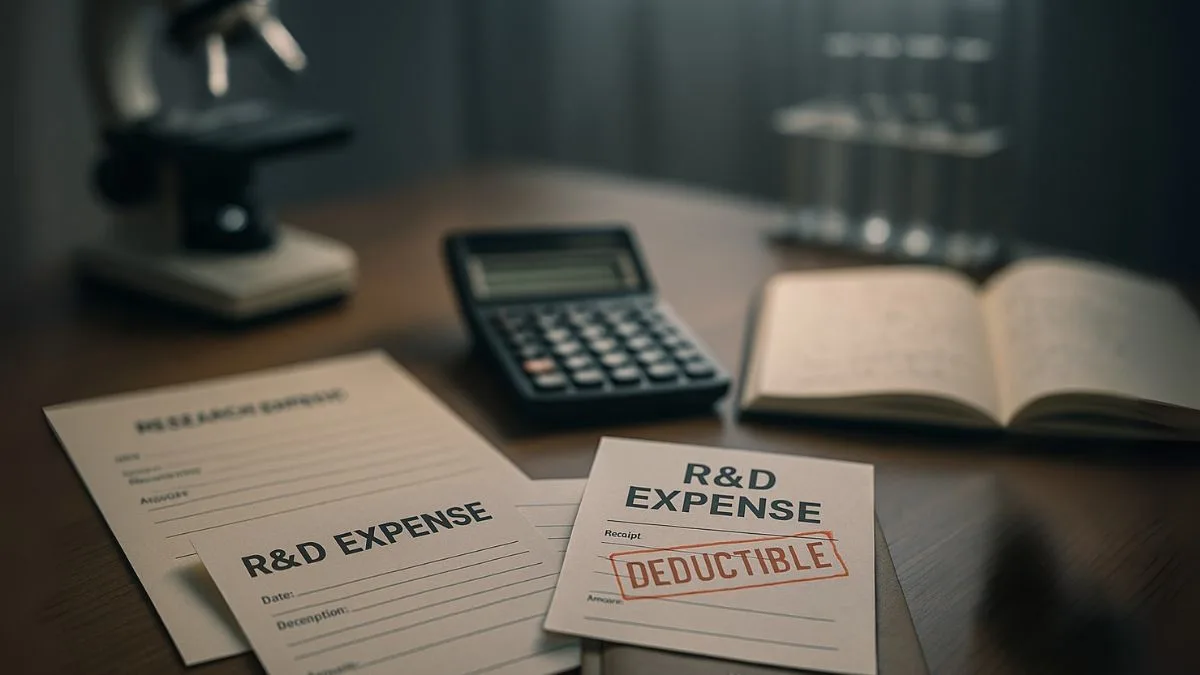
Research and development (R&D) has always been the backbone of industrial and economic growth. To encourage businesses to invest in innovation, the Government of India provides generous tax deductions under the Income Tax Act, 1961. One of the most significant provisions is Section 35(1)(i), which specifically deals with the deduction for revenue expenditure on scientific research related to the business of the taxpayer.
Unlike capital expenditure, which creates long-term assets, revenue expenditure usually covers recurring costs such as salaries of research staff, consumables, raw materials used in experiments, and operational expenses. Section 35(1)(i) recognizes these costs as essential for fostering research and ensures that businesses are not burdened with additional tax liability for such spending.
This blog provides a complete guide on Section 35(1)(i) – its scope, eligibility, types of expenses covered, practical examples, and why it remains a critical tool for businesses investing in scientific research.
What is Section 35(1)(i) of Income Tax Act?
Section 35(1)(i) of the Income Tax Act states that:
“Any expenditure (not being in the nature of capital expenditure) laid out or expended on scientific research related to the business shall be allowed as a deduction in computing the taxable income.”
In simple terms, this section provides for the deduction of expenses incurred on scientific research, provided that the expenses are revenue in nature & are directly related to the business of the taxpayer.
This provision helps companies, partnerships, & even individuals engaged in business to claim a 100% deduction of revenue expenses incurred on scientific research during the same year in which such expenses are made.
Key Features of Section 35(1)(i)
- Type of Expenditure Covered – Only revenue expenditure is allowed as a deduction.
- Link to Business – The expenditure must be related to the business carried on by the assessee.
- Full Deduction – The entire expenditure is deductible in the year it is incurred.
- Exclusion – Capital expenditure like purchase of land, buildings, or long-term assets is not covered under this sub-section (but may be covered under other clauses of Section 35).
- Purpose – The aim is to promote R&D by removing tax hurdles on recurring research costs.
Did you know? Businesses can claim a 100% deduction for scientific research expenses — but only if structured the right way. 👉 Click Here
Revenue Expenditure – What Does it Include?
To understand Section 35(1)(i), it is important to identify what qualifies as revenue expenditure on scientific research. Some common examples include:
- Salaries, wages, and benefits paid to scientists, engineers, and researchers.
- Cost of raw materials & consumables used in research experiments.
- Utility bills & laboratory expenses.
- Expenditure on training research staff.
- Rent for premises used for R&D.
- Professional fees paid to consultants assisting in research.
- Trial and error expenses in developing prototypes (excluding capitalized machinery).
Thus, any expenditure (not being in the nature of capital expenditure) laid out or expended on scientific research related to the business is allowed.
Also Read: Deduction for Scientific Research Contributions
Examples for Better Understanding
Example 1: Pharma Company
A pharmaceutical company spends ₹50 lakhs in a financial year on raw materials, laboratory chemicals, and salaries of its research staff working on a new vaccine. Since these costs are not capital in nature, they qualify as revenue expenditure & are fully deductible under Section 35(1)(i).
Example 2: IT Company
An IT firm hires a team of software engineers to research advanced AI models. Salaries & overheads incurred during the year are revenue expenses. These can be deducted under Section 35(1)(i)."
Example 3: Manufacturing Business
A textile manufacturer sets up a lab for testing eco-friendly dyes. Expenditure on consumables, utilities, and researcher salaries qualifies as revenue expenditure. But if the company purchases lab equipment, that will fall under capital expenditure, not Section 35(1)(i).
Difference Between Revenue Expenditure and Capital Expenditure
|
Basis |
Revenue Expenditure |
Capital Expenditure |
|
Nature |
Recurring, day-to-day |
One-time, long-term |
|
Examples |
Salaries, raw materials, rent |
Purchase of land, building, equipment |
|
Covered under |
Section 35(1)(i) |
Section 35(1)(iv) |
|
Deduction Availability |
Fully deductible in same year |
Deduction allowed as per specified rules |
Revenue expenditure on scientific research sounds simple, but one wrong classification can lead to disallowance. Curious if your claim is safe? 👉 Click Here
Why Section 35(1)(i) Matters for Businesses
- Encourages Innovation – Reduces the cost burden of conducting R&D.
- Boosts Global Competitiveness – Helps Indian firms compete by lowering effective costs.
- Tax Planning Tool – Reduces taxable income significantly, creating real cash savings.
- Promotes Start-ups – Small businesses investing in R&D can claim immediate relief.
- Supports Industry Growth – Sectors like pharmaceuticals, IT, chemicals, & manufacturing benefit the most.
Compliance and Documentation
For claiming deduction under Section 35(1)(i), businesses should maintain proper records, such as:
- Salary slips and agreements of R&D staff.
- Purchase invoices of consumables & materials.
- Utility bills and rent agreements.
- Research project documentation & reports.
- Auditor certification (if required).
Accurate documentation ensures smooth processing during income tax assessments.
Judicial Interpretations
Indian courts have upheld the broad interpretation of Section 35(1)(i). Some notable rulings include:
- CIT v. Alembic Chemical Works Co. Ltd. – The Supreme Court observed that research aimed at improving existing processes is also eligible for deduction.
- CIT v. Modi Spinning & Weaving Mills Co. Ltd. – Revenue expenditure on salaries of research staff is deductible, even if the research doesn’t result in immediate profits."
These cases highlight that the success of research is not a condition – what matters is that genuine expenditure is incurred for business-related scientific research.
Also Read: Tax Deduction on Donations to Approved Scientific Institutions
Tax Benefits and Impact
Let’s assume a company has a gross income of ₹10 crores & spends ₹1 crore on revenue expenditure for scientific research.
- Without deduction: Taxable income = ₹10 crores.
- With Section 35(1)(i) deduction: Taxable income = ₹9 crores.
At a corporate tax rate of ~25%, this results in a tax saving of ₹25 lakhs, directly boosting profitability.
Conclusion
Section 35(1)(i) of Income Tax Act is a vital incentive for businesses engaged in innovation. By allowing deduction for any expenditure (not being in the nature of capital expenditure) laid out or expended on scientific research related to the business, it ensures that Revenue Expenditure on R&D is fully deductible. This provision not only reduces tax liability but also strengthens India’s ecosystem for innovation & research.
If your business invests in research and development, knowing how to use Section 35(1)(i) effectively can save you significant tax.
👉 To understand how you can maximize deductions on scientific research expenses and build a smart tax strategy, connect with us at Callmyca.com – your trusted partner for tax planning and compliance.











